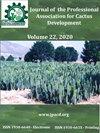在墨西哥中部不同管理方式下,皮塔亚麻 Stenocereus pruinosus 和 S. stellatus 的损害特征及其对产量的影响
IF 0.4
4区 农林科学
Q4 HORTICULTURE
Journal of the Professional Association for Cactus Development
Pub Date : 2023-11-30
DOI:10.56890/jpacd.v25i.527
引用次数: 0
摘要
几种柱状仙人掌的使用可以追溯到几千年前,现在仍在继续。其中许多仙人掌的种群在其分布范围内受到三种形式的管理,包括野生、原地和栽培,每种形式都受到不同类型的生物或物理损害。本研究试图描述影响墨西哥中部和南部皮特兰(Stenocereus pruinosus 和 S. stellatus)的损害类型,并分析不同管理形式下某些损害类型之间的关系及其对繁殖成功率的影响。这两个物种在三个不同管理形式的种群中取样。选取的枝条(167-180 个)测量了受害量,确定了受害类型,并估算了总受害量的百分比和整个结果期的果实数量。采用 x2 检验来确定损害特征的变化,并利用线性回归评估损害对不同管理形式种群果实产量的影响。列出了八种不同类型的损害、其发生频率以及损害对果实产量的影响。根据人为管理的不同,管理的种群表现出了番荔枝种植者对某些损害类型的接受程度:鸟巢和外部黑疤,它们不会影响果实的产量;而减少其他损害类型,如枝干腐烂和蚂蚁食草,后者会影响果实的产量。鱼眼病、人为病害、灰痂病、煤烟霉和枝干腐烂病的危害应在所有种群的植物健康活动中加以解决,并应与番木瓜种植者开展知识交流,以提出应对这些危害的措施。这将有助于该物种的可持续利用。本文章由计算机程序翻译,如有差异,请以英文原文为准。
Characterization of the damage and its effect on the production of pitayas Stenocereus pruinosus and S. stellatus under different forms of management in Central Mexico
The use of several columnar cacti stretches back several thousand years and is still going at the present. In many of them, their populations within their range of distribution, are subject to three forms of management, including wild, in situ, and cultivated, each of one exposed to different types of damage, biological or physical. This study attempted to characterize the types of damage affecting pitayas (Stenocereus pruinosus and S. stellatus) in central and southern Mexico, and to analyze the relationship between some types of damage under different forms of management, and its effect on reproductive success. The two species were sampled in three populations with different forms of management. The branches (167-180) were selected and measured the amount of damage, characterized the types of damage, and a percentage of the total damage together with the number of fruits that were produced throughout their annual fruiting season were estimated. A x2 test was used to determine the variations in the characterized damage, and the effects of the damage on fruit production in populations with different forms of management was assessed using linear regressions. The eight different types of damage were listed, its frequency, and the effect of damage on fruit production varies in populations. Depending on human management, populations managed demonstrate acceptance of some types of damage by pitaya farmers: bird nests and external black scar, which do not affect the production of fruits; and reduction of others, branch rot and ant herbivory, the latter of which does affect the production of fruits. The fisheye disease, anthropogenic, gray scab and sooty mold and branch rot damage should be addressed in plant health activities in all populations, and the exchange of knowledge with pitaya farmers should be developed to propose measures to attend to these damages. This will support the sustainable use of the species.
求助全文
通过发布文献求助,成功后即可免费获取论文全文。
去求助
来源期刊

Journal of the Professional Association for Cactus Development
Agricultural and Biological Sciences-Plant Science
CiteScore
1.10
自引率
33.30%
发文量
10
期刊介绍:
The editors of the Journal of the Professional Association for Cactus Development, are very excited to be a part of the excellent editorial committee and to work together to create the synergism between scientists, growers, legislators, and business people so vital to the development of this industry to serve the people of arid lands.
 求助内容:
求助内容: 应助结果提醒方式:
应助结果提醒方式:


